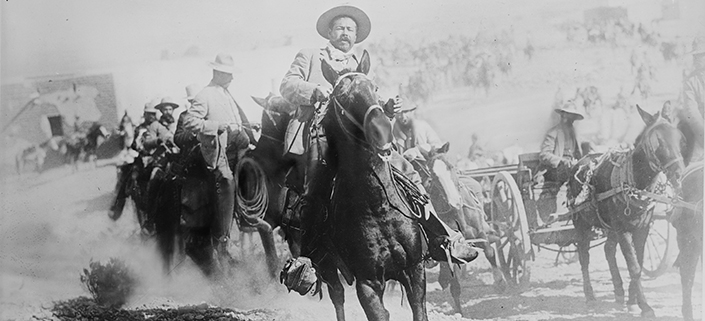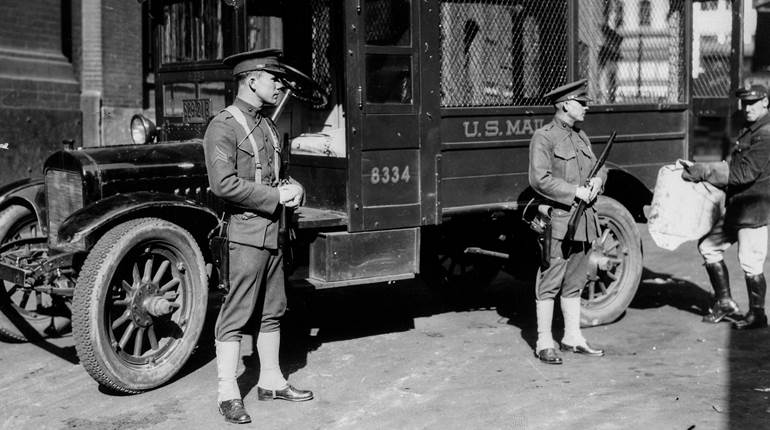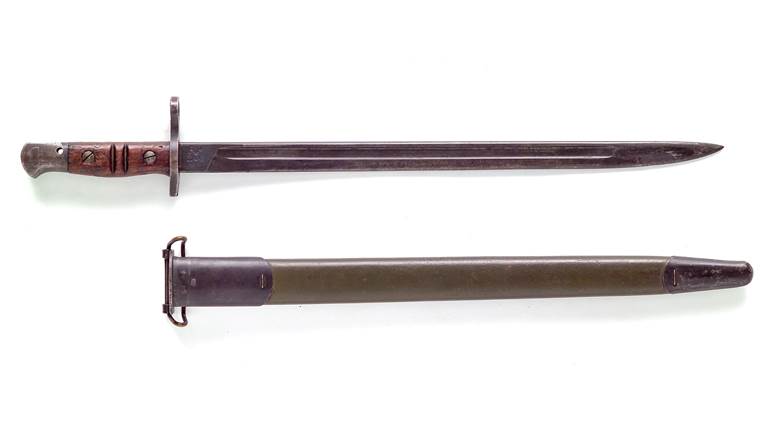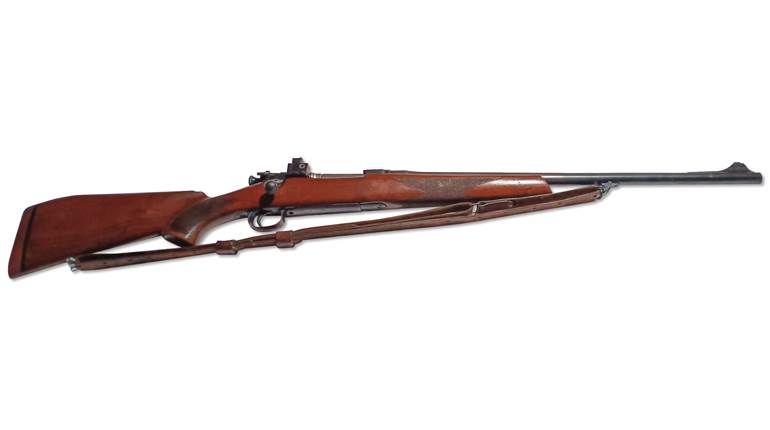
Banditry from Francisco “Pancho” Villa (above, circled) and his followers led to a U.S. Army “Punitive Expedition” into Mexico led by then Brig. Gen. John J. Pershing.

In the second decade of the 21st century, the border between the United States and our neighbor to the south has been the subject of contentious debates and a great deal of angst. The concerns primarily involve the safety of American citizens and, in the eyes of some, an affront to our national sovereignty from the misdeeds of criminal elements crossing the border from Mexico. It may be surprising to some, but this issue also plagued our nation during the second decade of the 20th century as well. But 100 years ago, the lawlessness wasn’t perpetuated by vicious drug cartels as is the case today. Rather, the problems were due to violence and unrest stemming from the ongoing Mexican Revolution.

In 1913, the sitting government, headed by President Francisco Madero, was overthrown by factions loyal to Gen. Victoriano Huerta, who was extremely antagonistic toward the United States for its perceived support of the former government. Relations continued to deteriorate and reached a flashpoint in 1914 when nine unarmed American sailors were arrested and detained for allegedly entering a restricted area. Although the sailors were soon released unharmed, the United States was not placated and, on April 21, 1914, contingents of U.S. Marines and Navy “Bluejackets” landed and seized the port city of Vera Cruz. Heavy fighting resulted over the next few days, but eventually the United States forces prevailed and garrisoned the city until it was turned over to the control of three South American nations tasked with negotiating peace among the warring factions. Relations between the United States and the Mexican revolutionaries changed from antagonistic to toxic.
The Huerta regime, which had seized power from the Madero government, was being challenged by elements of an uprising led by Venustiano Carranza. In order to bolster his power, Carranza joined forces with an infamous bandit, Francisco “Pancho” Villa. Villa used the pretext of political revolution as an excuse to increase his efforts to pillage and plunder. While the United States eventually mended fences with Carranza and officially recognized his government, Villa viewed this as betrayal and vowed retaliation against the Americans.
For the next couple of years, Villa and his henchmen crossed into the United States on numerous occasions and stole livestock and other valuables. Eventually, the situation devolved into more serious violence when followers of Villa murdered 17 U.S. citizens traveling on a train in Mexico. This, understandably, caused a furor in the United States. An attack on the town of Columbus, N.M., on March 9, 1916, during which 18 Americans were killed, resulted in such public outcry that President Woodrow Wilson was forced to take decisive action. Wilson directed the U.S. Army to pursue Villa into Mexico and exact revenge for his actions. General Fredrick Funston, commander of the Army’s Southern Department, had telegraphed the War Dept. the day after the Columbus attack: “I urgently recommend that American troops be given authority to pursue Villa into Mexican Territory [in pursuit of] hostile Mexican bandits who raid American territory. So long as the border is a shelter for them they will continue to harass our ranches and towns to our chagrin.”
General Funston’s recommendation was approved, and a “Punitive Expedition” was organized by the U.S. Army for the purpose of pursuing Villa and his men, and punishing them for their actions against American lives and property. General John J. Pershing, a veteran of the Indian Wars, the Spanish-American War and the Philippine Insurrection, was appointed commander of the expedition. On March 15, 1916, Pershing led a contingent of American troops across the border into Mexico. Eventually, some 10,000 troops were involved in the campaign.
The Punitive Expedition was notable for its use of aircraft and motor vehicles, but both proved inadequate for their intended purposes. The logistics of the campaign soon became chaotic. There were numerous small-scale skirmishes with Villa’s followers with mixed results, and the campaign never really achieved its stated goals. But the blunders that resulted proved to have a silver lining as they vividly pointed out areas that the U.S. Army needed to address and solve, especially since the nation would be at war in Europe less than a year later. The Punitive Expedition has been referred to as a dress rehearsal for World War I. Like many such endeavors, thankfully, the “main event” profited from mistakes made during the rehearsal. The Mexican campaign was also a chance for U.S. infantry arms to be evaluated under actual field conditions.


U.S. Model 1903 Springfield Rifle
The ’03 Springfield was adopted to correct the deficiencies found in the U.S. Krag rifle in .30-40 Krag when it went up against Spanish troops armed with Model 1893 Mausers during the Spanish-American War of 1898. The Mausers proved to be superior to the Krag in many respects, and the U.S. Ordnance Dept. was forced to look for a new service rifle, even though the Krag had been adopted less than a decade earlier. A new bolt-action repeating rifle, heavily influenced by the Mauser, was selected to replace the Krag. It was standardized as the “U.S. Rifle, Caliber .30 Model of 1903.” The main advantages of the M1903 over the Krag were a stronger bolt with two locking lugs and the ability to be loaded by a charger (stripper clip), both features that were attributes of the Mauser. The stronger bolt permitted the use of a more powerful cartridge. The new rifle was initially chambered for the .30-’03 cartridge, which was followed three years later by the excellent .30-’06 Sprg. (.30 Springfield). The new round was markedly superior to its predecessor.
The M1903 rifles were accompanied by the Model 1905 Bayonet, which featured a 16" blade. The bayonet was carried in the Model 1910 scabbard, which was fitted with metal hooks that secured it to the standard cartridge belt.
The ’03 was manufactured by the U.S. Springfield Armory and Rock Island Arsenal, and it was the standard American service rifle at the time of the Punitive Expedition. It proved its mettle in Mexico in 1916, as it would again in the brutal trench warfare of the Western Front during World War I. The venerable M1903 Springfield is widely considered to be one of the best bolt-action military rifles of this, or any other, era.


U.S. Model 1903 Springfield Rifle With Warner & Swasey “Musket Sight”
Some Model 1903 rifles fitted with Warner & Swasey Model 1913 “Musket Sights” were also fielded during the Punitive Expedition campaign. The Warner & Swasey sight was a rather unusual prismatic design that permitted a wide field of view as compared to more conventional telescopes. In the vernacular of the day, the telescopes were called “Musket Sights.” The first pattern Model 1908 Warner & Swasey sight was fitted to some select Model 1903 rifles at Springfield Armory from 1909 to 1912. The Model 1908 was soon followed by the slightly improved Warner & Swasey Model 1913. Some M1903s with Model 1913 Warner & Swasey sights were fielded during the campaign against Villa, although some of the earlier Model 1908 Warner & Swasey sights are believed to have been used as well. Anecdotal evidence indicates that some ’03s were additionally fitted with Maxim silencers, thus becoming the first suppressed U.S. military sniping rifles. Little has been recorded regarding the early Model 1903/Warner & Swasey sniper rifles during the Mexican campaign, but the effect of their utilization in the conflict would have been, at best, marginal. The ’03 with Model 1913 Warner & Swasey Musket Sight was the standard U.S. Army sniper rifle outfit during World War I and saw widespread use by Doughboy snipers on the Western Front. But, while the M1903 was a superb rifle, the Warner & Swasey telescope proved to be less than satisfactory and was dropped from the Army’s inventory in the 1920s.


Colt Model 1911 .45 Pistol
The ’03 Springfield was not the only firearm used during the Punitive Expedition that would become an icon of the U.S. military. Designed by the legendary John M. Browning, the semi-automatic Model 1911 pistol was chambered for the potent .45 ACP (Automatic Colt Pistol) cartridge and utilized a seven-round detachable magazine. The .45 ACP cartridge was adopted, in large measure, because of the failure of the .38 Colt revolver as a reliable man-stopper during the Philippine Insurrection, which occurred in the aftermath of the Spanish-American War. The double-action .38-cal. Colt revolvers were adopted in the early 1890s and intended to be a replacement for the obsolescent .45 Colt Single Action Army revolvers. The .38s demonstrated a lack of stopping power during close-quarter combat in the Philippines, though, and the Model 1911 pistol and .45 ACP were eventually adopted to rectify this problem. It soon proved to be one of the best military combat handguns of all time. Prior to World War I, the Model 1911 pistol was manufactured by Colt. In addition, a relatively small number were also made by Springfield Armory in 1914 and 1915.
The M1911 saw extensive use during the 1916 Mexican Punitive Expedition by both U.S. Army infantry and cavalry troops. The pistol performed its duties in an exemplary manner, as it did on countless battlefields over the subsequent 80 or more years.
The M1911 remained the standard U.S. Army handgun during World War I and saw widespread combat use in France. It proved its value in the small-scale, but often brutal, actions such as the “Banana Wars” in the 1920s and 1930s. The slightly improved M1911A1 pistol was manufactured and used in large numbers during World War II, along with many refurbished M1911s. As was the case with the ’03 rifle, the M1911 was one of the most popular arms used during the 1916 Expedition and served our troops well.


Model 1909 Benet-Mercie Machine Rifle
While the ’03 Springfield and the M1911 were superb and routinely performed in an excellent manner, the same cannot be said for the standard U.S. Army light machine gun of the era, referred to in official documents as an “Automatic Rifle.” Developed by two employees of the French firm Hotchkiss, the gun was adopted in 1909 as the “Model of 1909 Benet-Mercie Machine Rifle.” The standard U.S. infantry machine guns of the early 20th century were belt-fed designs mounted on heavy and bulky tripods; the Model 1895 and Model 1904. Both guns generally functioned satisfactorily, but they were quite heavy and cumbersome. The air-cooled Model 1895 weighed more than 90 lbs., and the water-cooled Model 1904 exceeded 150 lbs. There was an obvious need for an automatic arm that could be more easily transported by infantry and cavalry.
The Model 1909 Benet-Mercie Machine Rifle, which weighed only about 30 lbs., was deemed to be the gun the Army was looking for. Chambered for the same .30-’06 Sprg. cartridge as the M1903 rifle, the Benet-Mercie utilized a 30-round metal feed strip and fired at the rate of approximately 400 rounds per minute. The U.S. M1909 Benet-Mercie was manufactured by Springfield Armory and Colt with a combined production of 670 guns. Interestingly, the Model 1909 Machine Rifle was fitted with the previously-mentioned Model 1908 Warner & Swasey Musket Sight to aid in long-range firing.

The Benet-Mercie’s baptism of combat occurred during the Punitive Expedition—during which its inherent flaws became all-too-apparent. The gun had a tendency to break firing pins, which required complete disassembly. This proved to be extremely difficult, especially at night. A scathing official report on the performance of the Benet-Mercie during combat action with the Villa forces was written on March 14, 1916. Among other things, the report indicated that a major problem encountered was the difficulty in loading the feed strips, particularly at night, when the gunners were unable to see what they were doing. The feed strips could be loaded upside down, which caused the gun to jam. When the report was issued to the press, many newspapers ran derisive and mocking articles, and the weapon was dubbed the “daylight gun.” It was sarcastically suggested that the rules of warfare should be amended to only schedule combat during the daytime. The Chief of Ordnance for the U.S. Army, Gen. William Crozier, commented: “[W]e have no gun of any kind that can be used at any time except in daylight by a man who must depend upon his eyesight for such operations … .”
Clearly, the Model 1909 Benet-Mercie was a flawed arm, and it is not surprising that the guns were not used in combat by American forces during World War I. Soon after the Mexican Punitive Expedition, the gun dropped out of Uncle Sam’s arsenal. If the flaws of the Benet-Mercie had not been exposed in Mexico in 1916, perhaps the guns would have been utilized in combat during World War I. If so, the experienced and battle-hardened Germans would have exacted a much greater toll due to the foibles of the M1909 than did Villa’s rag-tag bandits.

Lewis Machine Gun
While use of the Model 1909 Benet-Mercie during the Mexican Punitive Expedition has been discussed in a number of books and articles, it is a lesser-known fact that some Lewis light machine guns were also employed during the campaign. Invented by U.S. Army Col. Isaac Newton Lewis, the Lewis was one of the better guns of its type at the time. For a number of reasons, including petty jealousy within the Ordnance Dept. hierarchy, the Lewis received lukewarm support from the U.S. Army. Nonetheless, the Lewis gun did prove to be a success with several European allies, chiefly Great Britain. Large numbers of Lewis guns chambered for the .303 British cartridge were fielded during World War I for both infantry and aircraft use by our allies (some lucky Doughboys received them instead of Chauchats, too, but that’s another story). The Lewis fed from a 47-round magazine for infantry use, and an aircraft version was made that held 97 rounds. The Lewis gun fired at the rate of approximately 600 rounds per minute.
In the fall of 1916, the U.S. Army purchased 353 Lewis guns, in .303, from the British. Those guns were dispatched to the U. S. Army’s “Southern Department,” and a number were employed in combat against Villa’s forces. Unlike the Benet-Mercie, the Lewis guns performed well. It is interesting to note that the guns used by the U.S. Army during this period were chambered for the standard British .303 cartridge—not .30-’06 Sprg.
Despite its good performance in Mexico, the Lewis gun was only grudgingly accepted by the U.S. Army, and it was not until 1917 that any sizeable number of Lewis guns chambered for the standard U.S. .30-’06 Sprg. cartridge were made under government contract. These were largely relegated to state-side training roles and front-line American combat troops were not equipped with Lewis machine guns during World War I unless they were under British command.

Lessons Learned
Even though it ended in a less-than-satisfactory manner, the Mexican Punitive Expedition proved to be of value, as it enabled the Army to evaluate the various arms employed under actual battle conditions and determine which ones “made the grade” and which ones didn’t. A couple of them, the Model 1903 rifle and the Model 1911 pistol, remained in active service with the U.S. military for a number of decades after the Mexican campaign. The Lewis gun eventually saw some service with the U.S. military between the wars and as a supplemental arm during World War II on some Navy landing craft and similar uses. The Model 1909 Benet-Mercie Machine Rifle, on the other hand, received a failing grade and was soon put out to pasture. It was better to have the flaws of the various small arms exposed while dealing with the bandits in Mexico than against the skilled, experienced and determined Germans on the Western Front.
Like beauty, the outcome of the Mexican Expedition is in the eye of the beholder. It can, with some justification, be described as a blunder-filled fiasco. On the other hand, it can be considered a tune up that paid dividends a short time later when the Doughboys were called to arms in the Great War. Whether the various arms employed by the U.S. troops in Mexico proved to be a success or a failure, all are nevertheless interesting and historic pieces that played a unique role in the history of American military arms.




































